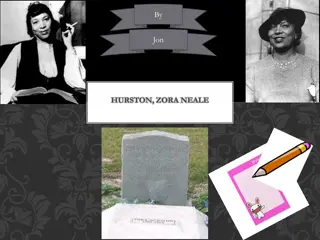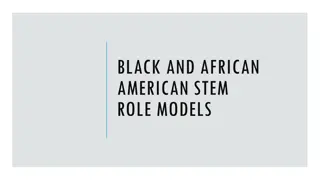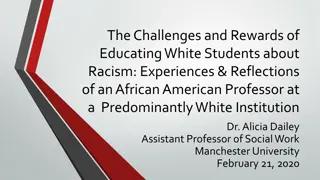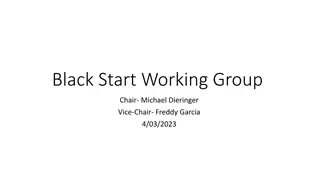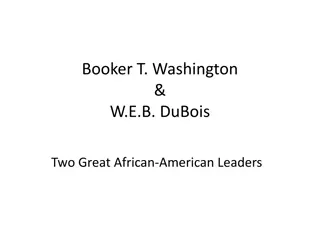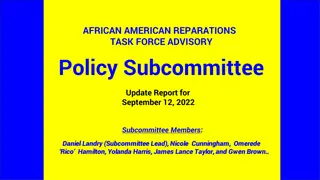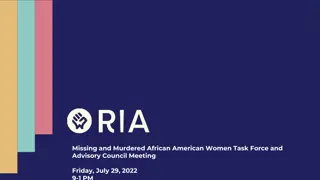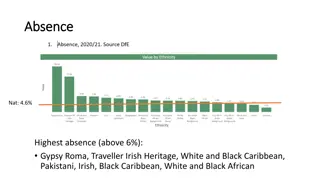Early Learning Systems for African American/Black Student Success
The presentation focuses on the Early Learning Division's initiatives in Oregon to ensure African American/Black children are prepared for school. Responsibilities include overseeing early childhood programs, aligning services with child-centered outcomes, and supporting at-risk children. The goals aim for children to succeed in kindergarten, healthy families, and a coordinated early learning system. The presentation also highlights the structure, customers served, and the percentage of African American/Black children living in poverty.
Download Presentation

Please find below an Image/Link to download the presentation.
The content on the website is provided AS IS for your information and personal use only. It may not be sold, licensed, or shared on other websites without obtaining consent from the author. Download presentation by click this link. If you encounter any issues during the download, it is possible that the publisher has removed the file from their server.
E N D
Presentation Transcript
PRESENTATION TO AFRICAN AMERICAN/BLACK STUDENT SUCCESS PLAN COMMITTEE NOVEMBER 2015 Megan Irwin, Early Learning Systems Director
Responsibilities 2 HB 3234: ELD established as part of the Department of Education in 2013 to ensure that children enter school ready to learn. Responsible for the administration of early learning and development programs in the state, for regulating licensed child care; for administering CCDF; and for the creation of a cohesive early learning system in the state. SB 909: Functions under the direction and control of the Early Learning Council with the Early Learning System Director as the administrative officer.
Governance 3 The Early Learning Division is governed by the Early Learning Council. Charged by statute to: Oversee a unified system of early childhood services including funding and administration (including rule promulgation). Align services with child centered outcomes. Align work between health care and early childhood education and K-12 and early childhood education. Focus on children who are at risk of arriving at school unprepared for kindergarten. Early Learning Systems Director is appointed by the Governor
Early Learning Divisions Goals 4 Children arrive at kindergarten ready to succeed. Families are healthy, stable and attached. The Early Learning System is coordinated, aligned and family-centered.
Early Learning Structure Governor s Office Youth Early Learning Council Development Council Early Learning Division (Part of Oregon Department of Education) DHS ERDC OHA
Customers 230,000 children under age 5. 45,000 children born a year are born on Medicaid. 25% of Oregon s under five population considered at risk by definition of statute (HB 4165). 4,500 licensed child care and early learning and development program providers serving 137,000 children. Another 2,918 license exempt providers who care for 7,276 children on child care subsidy.
Children in Poverty 7 Percentage of Children 0 - 5 Living in Poverty by Race/Ethnicity* 70% 60% AI/AN 50% Asian Black 40% Hispanic 30% Hawaiian/ Pacific Is. 20% White 10% Multiracial 0% 2010 2011 2012 2013
BUDGET Early Learning Division
ELD 15-17 Legislatively Approved Budget 15-17 Current Service Level $376.7 General Fund, $209.9, 56% Federal Funds, $153.3, 41% Other Funds, $13.5, 3%
ELD 15-17 LAB Special Payments Total Funds $343.1 million Kindergarten Partnership, $9.1 , 3% Early Head Start, $1.6 , 0% Healthy Families Oregon, $28.5 , 8% Oregon Pre- Kindergarten, $140.0 , 41% Race To The Top, $9.3 , 3% Relief Nurseries, $10.3 , 3% Office of Child Care, $125.4 , 37% Early Learning Hubs, $18.9 , 5%
Federal funds Head Start Collaboration/misc grants, $0.3 , 0% Race To The Top, $18.3 , 12% Child Care Development Fund, $135.2 , 88%
Early Learning Programs Child Care Licensing Oregon Relief Nurseries Healthy Families Oregon Kindergarten Assessment Migrant and Seasonal Preschool Oregon Pre-K & Head Start Preschool Promise QRIS Vroom
2015-2017 Priorities Supports for infants and toddlers Supports for pre-k aged children Supports the workforce Supports for families Organizational excellence
Early Learning Hubs First funded in 2013 and governed by ORS 417.827. Designated by regional partners to coordinate early learning services and produce better outcomes for at-risk children under 6. Core responsibilities are: finding populations children experiencing greatest disparities, identifying their needs, working across sectors to connect them to services and accounting for outcomes collectively.
2. Identify the needs of Child and Families graph these children and their families. 3. Work across sectors to connect children and families to services and support that will meet their needs. Community 1. Identify the populations of children experiencing greatest disparities early in life. Child & Families 4. Account for Outcomes collectively across the system.
Connecting to K-12 Kindergarten Partnership and Innovation Fund First funded in 2013. Creates a connection between early learning and K-12 education by funding innovative community and school partnerships. Transitions to Kindergarten Family engagement Shared professional development Funding 16 projects across the state. 9,452 children benefiting from investments.
Early Learning Regulation and Quality Licensing and Compliance Background checks On-site health & safety monitoring of all licensed facilities Child Care Rule Revisions Complaints and public inquiries Child Care Subsidy
Early Learning Regulation and Quality, cont. Child Care Supports Licensing and regulation Oregon s Quality Rating and Improvement System encourages licensed child care providers to meet child learning and development standards and supports them in doing so. Child Care Resource & Referral Network Early childhood professional development system
Licensed Child Care in Oregon % of Licensed Facilities by Type 3% 23% Certified Center Certified Family Registered Family Head Start 16% 58% There are 4,286 licensed child care facilities in Oregon.
Office of Child Care 15-15 Legislatively Approved Budget 15-17 Legislatively Approved Budget Quality, $4.67 , 3% Licensing, $15.16 , 10% Quality, $4.39, 3% Licensing, $12.43 , 9% Special Payments, $130.40 , 88% Special Payments, $125.35 , 87%
Child Care Development Fund Total CCDF 2013-15: $133.2 million
Changes to CCDF Rules Stronger focus on child development New monitoring & safety requirements: On-site monitoring of licensed exempt providers Compliance by 11/19/2016 Fingerprinting and background checks Compliance by 9/30/2017 Enhanced requirements for parent and public access to complaints and compliance information Compliance by the earlier of a) 11/19/2017 or b) 1 year after monitoring in place
Office of Child Care & ERDC Outcomes Over 4,400 facilities monitored annually to ensure health and safety. 16% of children supported by Employment Related Day Care in Commitment to Quality or QRIS star- rated programs. 35% of the early care and education workforce achieved a Step 7 or higher on the Oregon Registry.
Accessing Quality Child Care 5 Star Where are the children? 4 Star 8,852 3 Star Commitment to Quality 27,928 Licensed 100,455 License-exempt receiving subsidy 7,276 License-exempt ??????
Accessing Quality Child Care, cont. 5 Star Where are the staff? 4 Star 1880 3 Star Commitment to Quality 4363 Licensed 9221 License-exempt receiving subsidy 2,918 License-exempt ??????
Demographics of children & providers 27 Child Care Provider Workforce by Race/Ethnicity 80% 75% 74% 73% 70% 60% 50% 2012 2013 2015 40% 30% 20% 17% 15% 14% 10% 4% 4% 4% 3% 3% 3% 2% 1% 1% 1% 1% 1% 1% 1% 0% 0% White Black Asian AI/AN Hawaiian/ Pacific Is. Multiple Races Hispanic
Whats next QRIS revisions 28 Oregon s Revised QRIS will: Ensure inclusion of diversity of cultures, communities of color, ethnicities, languages and abilities using the Oregon Equity Lens Be comprehensive but not cumbersome for providers Be sustainable and prioritize resources to increase access to quality care for children, families and communities furthest from opportunity Increase professionalism of the Early Learning field by encouraging continuous quality improvement across all levels of the system (system, workforce, program) Be efficient, effective and build upon existing systems Build upon the rich knowledge and expertise of Oregon s families and communities to support families as they choose child care Provide objective and understandable standards in accessible formats Be understood and valued by all stakeholders
Oregon Pre-Kindergarten Established in ORS 329.160 through 329.200; modeled and designed to work side by side with the federal Head Start program, thus referred to as OPK/Head Start . Serves 3- and 4-year-olds in poverty to ensure school readiness Providers include public schools, ESDs, higher education, and community-based non-profits (currently 28 providers with all 36 counties served). Both state and federal dollars are used in most programs but federal dollars do not flow through ODE. In total, OPK/Head Start served 13,321 children in 2013-14 and 13,762 children in 2014-15 (62.1% of eligible children- up from 50.9% in 2012-13). State-average annual expenditures per child are $8,384.
Demographics of children served (1) 30 Children Enrolled in Head Start/Oregon Pre-Kindergarten by Race/Ethnicity (June, 2015) 45% 42% 40% 35% 32% 30% 25% 20% 15% 10% 8% 7% 6% 5% 3% 2% 1% 0% White Black AI/AN Asian Hawaiian/ Pacific Is. Hispanic Other Multiracial
Mixed Delivery Pre-School $16 million given to ELC/ELD to expand pre-school in a mixed delivery model that builds on both the state s Head Start/OPK programs and allows K-12 elementary schools, community based organizations and licensed child care to become part of the state s formal pre-k system. Allows service for families up to 200% of the federal poverty level. 4-5 demonstration sites likely.
Community Engagement - Themes 32 Home Visits Important for cultural connections Transportation access to services Cultural awareness Supporting/being involved with the whole family Food security wrap around services Heath screenings wrap around services Helping break language barriers Support for BA requirement and request for help in getting there
Whats next? 33 Selection of demonstration sites by March 2016. Significant work to do to examine viability of the BA requirement for lead teachers and to develop systems that supports education of providers to support their practice, without creating institutional barriers.
Healthy Families Oregon First funded by the state in 1990 through ORS 417.788 HFO is an accredited, statewide home visiting program proven to reduce child abuse and neglect. Also impacts outcomes related to school readiness, child health and wellness, safety and family stability. Over 2,470 families received family support and coaching in 2014. The HB 2016 plan is a great place to call for flexible funds for culturally specific home visiting.
Healthy Families Oregon Outcomes Children who are served by HFO are 2 times less likely to be maltreated, compared to children not served by HFO (16 per 1,000 compared 40 per 1,000) Children whose mothers were enrolled in HFO are significantly more likely to be fully immunized at age 2 than the general population HFO mothers scored significantly lower, compared to control mothers, on the Parenting Stress Index, a validated measure of parent stress, which has been linked to risk of child abuse and neglect HFO mothers were 13 percentage points more likely to read to their babies on a daily basis than a control group
Race demographics of children served 36 2013 -2014 Children served through home visits 3% African American 28% Hispanic/Latino 4% Asian 1% American Indian 47% Caucasian 7% Multi Racial 2% other 9% Unreported
Relief Nurseries Comprehensive therapeutic support programs serving families with children under age 6. Children and families experiencing multiple stress factors; at risk for child abuse and neglect. Work to keep children safe in their homes, reducing the number of children in foster care. Provide therapeutic early childhood classrooms, home visits and parenting supports. Serves 3,319 children in 25 programs (15 core; 10 satellite) statewide.
Relief Nurseries Outcomes Reduces risk of child abuse and neglect Within 12 months families in program see risk factors drop from 9 to 7. 98.6% of children enrolled in services avoid foster care and continue living with families. Percentage of enrolled parents who report reading to their children at least 3x a week increases from 32% to 52% after six months in program.
Demographics of children served (2) 39 2013 2014 14% of mothers served were 17 years or younger 77% of mothers served were single mothers 34% of parents served had less than a HS Education 22% of mothers had late prenatal care 58% of parents served were unemployed 25% of mothers suffer from depression 25% of mothers reported relationship problems 87% of parents income was at or below the poverty level
Early Head Start First state funding in 2009-11 (funding distributed to existing providers). Services focus on cognitive, developmental, and socio- emotional supports; medical and dental screenings; nutritional services; mental health services; parental involvement; and referrals to social services for the entire family. Serves children under 3-years-old; expectant mothers at or below the poverty line; children in foster care who are homeless, or have other risk factors also qualify. 64 children served.




